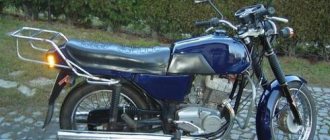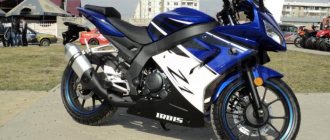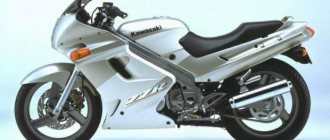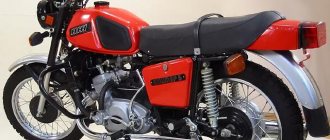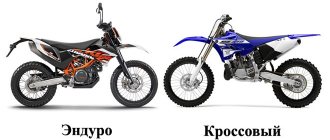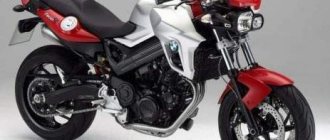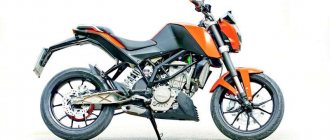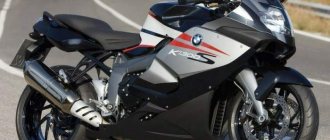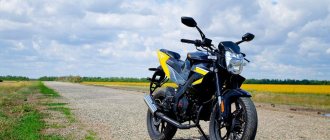"Soft core"
Why do beginners prefer this particular model? If only because the engine power is enough to feel the first injection of adrenaline, and not enough to fly into a ditch. Although there are specimens that manage this with ease.
The easily recognizable design attracts many fans of sports motorcycles. However, it is quite difficult to call the Honda CBR 600 F4i a pure “sport” - it is soft and supple in the city, fast and swift in good highway conditions. Ease of operation is one of the key advantages of the motorcycle. Even a beginner can handle it, which is why Honda is increasingly becoming the first motorcycle of girls and guys who see themselves on the race track in the near future.
About the motorcycle
Honda CBR600F4i
a sports motorcycle produced by Honda between 2001 and 2006.
In 2001, Honda released an improved version of the popular CBR600F4 motorcycle to compete in the middleweight sports bike category. This motorcycle was the F4i, weighing 170 kg. - a modified F4 model with numerous changes in the design of the engine, chassis and hull.
The only big change besides the appearance was the addition of high-pressure (50 psi) electronic fuel injection - which was reflected in the model name "F4i". In some countries, this motorcycle was sold in two versions - regular and sports versions. The sports version had a split two-piece seat and lacked a tail handle and a center stand (although there were mounts for it). The fuel injection system improves fuel delivery performance and extends the engine's rpm range, while delivering better throttle response, economy and lower emissions. Each cylinder had one injector with 38 mm throttle valves. Each injector had 4 nozzles, which increased the maximum engine power by 5 horsepower compared to the F4 model.
The dry weight of the motorcycle has also been reduced. The rear wheel was lightened by 400 grams, the front by 300 grams. The wheel bearings were moved outward, closer to the fork legs, and the brake calipers were placed closer to the mounts in order to reduce weight and improve rigidity. Also, the weight of each brake caliper has been reduced by 100 grams. An additional steering column mount was added for better handling. The suspension also features adjustable damping. The wheelbase has become shorter - 5 millimeters than the previous model. Hardness increased by 5.9%.
Technical points
Characteristics of the Honda CBR 600 F4i clearly demonstrates all the qualities that are necessary for a reliable and obedient “stallion”. The four-cylinder engine has a liquid cooling system. Each cylinder is equipped with four valves. The engine runs smoothly - without sudden jolts or jerks. The bike has a three-phase generator. Electronic ignition system - the engine is started using a starter.
The suspension easily responds to road changes, which is very convenient for rough terrain. The main advantages of a sports tourist include the following:
- unpretentiousness;
- ease of management and operation;
- ergonomic body;
- stylish design and moderate fuel consumption.
The disadvantages, or rather the possible and most common problems, will be discussed a little later. Now it's time to know the story of how the Honda CBR 600 F4i came to market.
Technical characteristics of Honda CBR 600 F4
The Honda CBR 600 F4 motorcycle can reach speeds of up to 250 km/h. It accelerates to 100 km/h in 3 seconds. Main characteristics:
- 81 kW or 110 hp power;
- transistor digital ignition;
- 4 valves per cylinder;
- liquid cooling system;
- double pipe, box type.
The engine capacity is 599 cm3. The fuel supply system uses a 4x36.5 mm carburetor. A 6-speed manual transmission is installed. Chain drive. The length of the motorcycle is 2060 mm, width 685 mm. Ground clearance 152 mm. Curb weight 197 kg.
The sleeves are made of an alloy of aluminum, silicon, and graphite composite. Individual ignition coils are installed for each spark plug. Gas tank capacity is 18 liters. Rear and front disc brakes. There is also an additional 1.4 liter tank. Multi-disc clutch in oil bath.
The motorcycle is equipped by the manufacturer with a new Pro Frame type frame. In its design, engineers used a pendulum hinge with rotation centers on the engine crankcase and frame. High-quality, very high-quality suspension and engine elements, the use of new technological solutions, made it possible to reduce the dry weight to 168 kg.
Story
Literally from the very first days of its birth and presentation, almost everyone fell in love with the motorcycle. Even fans of extreme driving appreciated the sufficient power of the engine and the prospects for using this model.
The so-called progenitor of the Honda is the 1983 Honda VF750F - the well-known “Vifer”, which went through several stages of modernization. A little later, a younger version of the VF500F appeared, which in 1987 was replaced by the first “Siberian” with the F1 index. At that time, the motorcycle was equipped with a 600 cc engine with a DOHC gas distribution system and 16 valves.
The Honda CBR 600 F4i motorcycle covered more than 400 meters in just 11.32 seconds - at that time this was a really cool indicator. There are 82 horses in the “stable”, which made it possible to accelerate the bike quite quickly. A little later, a second modification appeared with the index F2, which pleased motorcyclists with a herd of 100 hp. With. By the way, the design of this model remains attractive today.
Control
This is truly a separate topic of conversation that requires enthusiastic attention. Even a girl and an inexperienced driver can handle the bike. Light weight and excellent ergonomics of the entire body itself - all that remains to be added to this is that the Honda CBR 600 F4i instantly responds to every touch of the biker.
This model is simple and easy to operate. The chassis is stable enough to feel as confident as a Kawasaki or Suzuki, but the Sibierka reacts and maneuvers like a top-notch middleweight bike.
This device is equipped with an excellent road chassis, the better feel of which is facilitated by the excellent ergonomics of the entire body itself. The rider's position is straight and does not require significant movement of the entire mass onto the handlebars, which cannot be said about most Suzuki models. In essence, this is the so-called concept of a sports motorcycle, adapted for riding in urban conditions.
The effectiveness of this technique
But all this is more than compensated for by a successful combination of design, handling, ergonomics and safety for an affordable price of $7,899. Those who are forced to make trips of more than 300 km in one direction will appreciate the ease of landing, smooth ride, pleasant “buzz” of the 4-cylinder 16-valve engine and the precise operation of the six-speed gearbox. By the way, many consider second gear in this unit to be superfluous.
The CBR 600 F4/4i is as enjoyable to ride at low speeds as it is at high speeds. By high speeds we mean speeds of 250-260 km/h (some motorcycle owners talk about deliberately fibbing the speedometer as an alternative to the limiter, due to the “civilian” orientation of this bike. But be that as it may, even with the factory settings of the shock absorbers intact, there are bumps and Uneven road surfaces are “swallowed” quite quickly.
An undoubted advantage in operating this Honda “six hundred” is its budget in terms of consumables and spare parts: the moderate heat of the engine does not “eat up” oil and does not wear out tires as intensively as happens with namesakes with liter engines, and brake pads even more so “ live" much longer. Well, it’s not worth talking about the availability of various components.
In general, the unit is very good. Ardent fans and envious competitors even agreed that the bike is so perfect that it is sometimes boring.
Distinctive features of the model range
An updated version of the F4i was introduced to a wider audience in 2001. The index eloquently indicates that we are talking about the fourth generation of the model, already equipped with a fuel injection system, the so-called “4+”. But this is not all of the innovations. Unlike the Honda CBR 600 F4, the F4i has dual headlights instead of a single one, and a digital instrument panel with an analogue tachometer instead of the alarm battery.
Other innovations are not so easy to notice. The frame has been improved along with the steering column mount being strengthened. Additional stiffening ribs appeared along the “diagonals”, as well as the so-called “ears” of the engine mounts, which were included directly in the entire power structure. All this together increased the overall rigidity of the chassis.
Another highlight is that models intended for the European and Japanese markets were equipped with a HISS immobilizer. American versions were not equipped with this option, but overseas modifications of the Sibierka, not constrained by draconian environmental laws, received more efficient fuel injection settings. And, as a consequence of this, slightly increased power (by about 2-3 horsepower).
Characteristics
Technical characteristics of the Honda CBR600F4i
| Model Honda CBR600F4i | |
| Model year | 2001-2006 |
| Engine | |
| engine's type | In-line four-stroke engine, volume 599 cm3 |
| Engine model | PC35 |
| Number and arrangement of cylinders | 4 cylinders arranged in a row, vertically at an angle of 31 degrees |
| Number of valves per cylinder | 4 |
| Cylinder diameter/piston stroke, mm. | 67 / 42.5 |
| Compression ratio | 12.0:1 |
| Cylinder compression | 1.226 kPa (12.5 kg/cm2, 18 Psi) |
| Valve clearances | Inlet valve 0.20 ± 0.03 mm, exhaust valve 0.28 ± 0.03 mm. |
| Gas distribution system | DOHC; four valves per cylinder |
| Lubrication system | Power pressure with sump |
| Air filtration | Paper filter |
| Dry engine weight, kg. | 59 |
| Fuel system | Fuel injection system, Programmed Fuel Injection (PGM-FI) |
| Ignition system | Electronic, spark order 1-2-4-3 |
| Starting system | Electric starter |
| Charging system | Three-phase alternating current generator, power 0.433 kW at 5000 rpm. |
| Cooling system | Liquid cooling fan |
| Power | 110.2 hp (81 kW at 12500 rpm) |
| Torque | 6.6 kg/m at 10500 rpm. (65 Nm) |
| Transmission | |
| Transmission | Six-speed, manual, foot shift, 1-N-2-3-4-5-6 |
| Primary step-down stage | 1.822 |
| main gear | 2.813 / 2.875 (46/16) |
| Gear ratio 1 | 2.833 |
| Gear ratio 2 | 2.062 |
| Gear ratio 3 | 1.647 |
| Gear ratio 4 | 1.421 |
| Gear ratio 5 | 1.272 |
| Gear ratio 6 | 1.173 |
| Clutch | Multi-disc in oil bath |
| Drive unit | Chain |
| Electrical equipment | |
| Accumulator battery | 12 V, 8.6 Ah |
| Generator | 0.433 kW |
| Chassis | |
| Frame | Aluminum twin-spar, box-section |
| Front suspension | Telescopic fork, blade diameter 43 mm. |
| Rear suspension | Swingarm, adjustable gas monoshock |
| Front wheel travel, mm. | 120 |
| Rear wheel travel, mm. | 120 |
| Front fork tilt, degrees | 24.0 |
| Fork offset, mm | 96 |
| Front tire | 120/70 ZR17 |
| Rear tire | 180/55 ZR17 |
| Brake system | |
| Front brake | Double-disc, disc diameter 296 mm, hydraulic, four-piston caliper |
| Rear brake | Single-disc, disc diameter 220 mm, hydraulic, single-piston caliper |
| Dimensions, dimensions, weight | |
| Wheelbase, mm. | 1390 except version U, 1385 version U |
| Ground clearance, mm. | 135 |
| Height of footrests, mm. | |
| Seat height, mm. | 808 |
| Length, mm. | 2065 |
| Width, mm. | 685 |
| Height, mm. | 1135 |
| Dry weight, kg. | 171 except version U, 169 version U |
| Curb weight, kg. | 200 |
| Maximum load, kg. | 189 |
| Tank volume, l. | 18 |
| Reserve volume in the tank, l. | 3.5 |
| Dynamics and efficiency | |
| Maximum speed, km/h | 251 (Video with speedometer readings) |
| Acceleration from 0 to 100 km/h, sec. | |
| Travel 1/4 mile, sec./max. speed | 11.7 / 199 |
| Fuel consumption, l. at 100km | From 6.41 l. Mixed cycle 7.5 l. |
| Braking distance, m. 60 - 0 / 100 - 0 | 13.6 / 39 |
Who is it suitable for?
The Honda CBR 600 F4i manual is the first thing a potential motorcycle owner should take care of. The instruction manual will help you avoid serious problems, as well as fix your bike without going to a motorcycle service center.
Initially, the Sibierka was positioned as a full-fledged sportbike, quite suitable for daily use. At the time of its release, the F4i was Honda's more powerful 600cc machine. But, if the F4i was truly aimed at daily use, as eloquently evidenced by the sports-touring two-seater seat, then the Honda CBR 600 F4i Sport was intended for those who are not averse to hitting the track. Instead of a double seat, the usual separate pads were installed for the pilot and the second number.
As soon as the RR series appeared, which was distinguished by a more aggressive character and design, “Efki” smoothly migrated from the camp of sport bikes to the calmer class of sports tourists.
Honda CBR 600 F4i Stunt Bike
Perhaps this motorcycle can be called a favorite among stunt riders. Why did they like this bike? First of all, motorcycle equilibrists love it for the almost complete indestructibility of the frame (you can roll the bike an unlimited number of times), the engine’s loyalty to riding on the rear wheel, and the very immortality of the engine and the overall chassis.
A typical “stunt” vehicle is very easy to recognize - there is practically no plastic on it, but there is a powerful body kit in the form of a yoke on the tail or a massive cage of protective arches. If a Honda is needed specifically for these purposes, then it is better to look for an already prepared projectile, rather than engage in tuning yourself. In the end, the bike’s engine, although immortal, is still killable.
Specifications
- Length 2041 mm
- Height 1135 mm
- Wheelbase 1386 mm
- Ground clearance 135 mm
- Dry weight 168 kg
- Curb weight 196 kg
- Maximum load 175 kg
Width 685 mm
Chassis
Engine
- Type 4-stroke, 4-cylinder, in-line
- Volume: 599 cm3
- Compression ratio: 12:1
- Lubrication system Pressurized, intake in crankcase
- Cooling system: Liquid
- Air filter: Paper
- Weight: 59 kg
Fuel system
- Injection system: Injector
- Tank volume 18.2 l,
Transmission
- Clutch Disc, in oil sump
- Clutch rod Cable
- 6-speed gearbox
- Wheel Drive Chain
Ignition and electrics
- Ignition system: Electronic
- Engine start: El. starter
- Sources email Energy Alternator: Battery
Where to buy?
The technical characteristics of the Honda CBR 600 F4i are the first thing you should pay attention to when buying a bike. Judging by the reviews, finding a model in decent condition is not so difficult. Moreover, this applies only to models imported from abroad and those that have managed to get acquainted with domestic roads. Due to its mild nature and relatively low power, this bike is not as attractive as the more recent RRs that both beginners and serious racers like to look at.
Most often, the F4i is used as a vehicle in city traffic or as a long-range vehicle, as evidenced by numerous reviews. Due to these features, even used motorcycles retain their original characteristics. The CBR is not often the first to be purchased, so the motorcycle rarely encounters improper and extreme use, which cannot be said about the “four hundred”.
The price tag ranges from 180 to 320 thousand rubles. There is no correlation by year of release as such. The 2004 model may be a lot worse than the 2002 Honda CBR 600 F4i.
Selling a motorcycle, by the way, is also easy. With its characteristics and versatility, a buyer will be found very quickly, if, of course, you do not overdo it with the price of the device.
Photos and videos
What else you can read:
- Hyundai Tucson 2021
- Kawasaki Ninja – Modifications 600, 300 cc
- Hyundai Kona – South Korean small SUV
- Honda Accord 2021 – New 10th generation in the Russian Federation!
- Honda SRV (CR-V) - I don't change! Specifications, owner reviews
- New Kia Optima unveiled in New York
- In the top 5 – Chevrolet Cruze hatchback
- Photos of BMW X5 – all generations
Most common problems
A rattling timing chain is one of the most common defects that often occurs on CBRs. First, a rattling sound appears in the area of the cylinder head, which is caused by a timing chain tensioner with a weak spring. In particularly severe cases, the chain itself will need to be replaced. But in most cases, the problem can be resolved quite simply - you need to replace the tensioner with an original or mechanical one.
Judging by the reviews, the HISS immobilizer, found in the American version of the sports tourer, often causes its owner a lot of trouble. If you have chosen just such a model, you should take the second ignition key from the former owner, because the loss of the first copy is fraught with serious losses for the budget - you will need to replace all the locks and purchase a new control unit. This is approximately $1000.
text from Motorreview:
Oleg Tyurin,
photo:
Dmitry IvaikinHonda CBR 600F4: 2000, 599 cm3, 110 l. s., 250 km/h, $ 7600
Honda CBR 600F4, 2000, 599 cm3, 110 l. s., 250 km/h, $ 7600 Previous photo Next photo Many of my friends are prone to gigantism. If they buy a car, then they will disgustedly reject the option of less than five meters in length and four liters of engine capacity. If we are talking about a motorcycle, then the search is intensively carried out exclusively in the camp of “liter” devices. I feel sorry for them, but they cannot get cured for the same reason - they are looking for a more expensive doctor
Nature treated me more humanely, so when the question arose about replacing my R6, I focused again on the “six hundred”. To be honest, I was happy with almost everything about the Yamaha, but the gearbox clearly hinted that the second gear in it, from its point of view, was clearly superfluous, and the engine was noticed to have an immodest appetite in terms of “gobbling up” a liter or two of oil while the owner does not see. In other words, with age, the “senile ways” of the motorcycle began to seriously irritate me, and I began to look lustfully at younger ones...
Alas, the prose of life made its own adjustments to my plans and instead of a two-three-year-old, as I initially wanted, I had to be content with a four-year-old - at the start of the 2004 season - “old lady”.
Why did you choose Honda? Everything is explained quite simply. Having heard a lot about the fact that Kawasaki has even worse quality problems than Yamaha, I was actually left with a choice between two brands - Suzuki and Honda. Almost everyone liked the first one, but due to the frankly sporty landing, the choice was not in its favor. For me, normal operation means running 300 km one way every weekend, not to mention the fact that I like to travel a lot and for the 2004 season I had a serious trip planned to seven European countries. And here the Honda CBR600F had very strong arguments, first of all, in terms of ease of seating. Almost one hundred percent road builder. The seat is soft, and the mirrors are located at a very decent distance from the steering wheel, providing an “unpolluted” view. The engine also contributes to the complete “relaxation” of the pilot - no vibrations or strange mechanical noises. The same applies to the gearbox - everything is clear, verified, understandable and predictable. But it’s very bland, especially after the hysterically explosive R6. To get adequate acceleration, you have to turn the tachometer needle past 10,000 rpm, where finally at least some “movement” begins to occur in the mechanical interior of the motorcycle and a wave of acceleration is felt. And this despite the fact that from the previous owner I received a very serious set in the form of an Acrapovic “end”,
Power Commander and K&N filters! An Ohlins damper was “nailed” on the steering wheel... At the same time, I did not spare my hard-earned Franklins and took them to the ever-starving people to a tuning office, where the Power Commander received a four-hour tuning using its electronic “brains” on the Dynojet stand, followed by printing out the results to the trusting owner. The paper announced that almost four “extra” horses appeared in the engine, who did not want to labor and move my body in given directions. However, compared to even the stock R6, this entire arsenal looked very pale; the CBR frankly did not reach the Yamaha in terms of engine.
At such moments I began to regret that I had not bought a Suzuki, but the moments of weakness were short-lived. Honda takes it differently - with a combination of qualities. As soon as I escaped from the disgusted city, the blissful smile of the holy fool began to prop up the “cheeks” of my Shoei. Comfortable seating, a smoothly running engine in combination with very energy-intensive suspensions, meager fuel consumption (a little more than five liters at speeds up to 160 km/h) - these are the factors that made me smile so much, and not at all because of my inner psyche states!
I was pleased with the well-thought-out wind protection, although my standard windshield was replaced with a tuning one with a “hump.” On the CBR 600F, a passenger can also count on almost the same comfortable seat as a pilot - a very rare quality in the camp of 600s!
The undoubted advantages of operating a Honda also include the overall low cost of maintenance, mainly in terms of so-called “consumables”. The engine, unlike its “liter” namesakes, does not tear rubber to smithereens, which can easily last more than 5,000 km, even if it is some kind of super-soft Dunlop 208 GPI. Brake pads last even longer. There is no oil consumption. In general, spending is quite tolerable and acceptable. On the other hand, I didn’t expect anything else from Honda. Every detail, even the most insignificant, on this motorcycle is made with very high quality and precision. This also applies to the “readability” of the dashboard.
But there are a couple of points that, unlike the R6, do not suit me at all. First, the meager volume of underseat space, which, given the general focus of the motorcycle on ease of everyday use, is, to say the least, surprising and brings many minor everyday inconveniences. The second stems from the comfortable position of the pilot: the footpegs begin to scrape the asphalt too early, sometimes even in the city, not to mention the track.
Speaking of tracks... Over the past season, we managed to make several trips both to Dmitrov and Myachkovo. There were no revelations. For a high-speed Dmitrov, where engine power is very important, the Honda is rather weak. In the more technically complex Myachkovo the situation is somewhat better, but even here, in comparison with the same R6, the general “civilian” orientation of the motorcycle is obvious. And this despite the fact that in the front fork I have reinforced springs from the same Ohlins! The track is not this bike's strong point. But how many days does the average motorcyclist spend in the everyday bustle of the city and how many on the track? That's it.
Somewhere in the middle of last season, I realized that if I didn’t immediately come up with at least some kind of trip for myself, then, having become completely brutal from the traffic jams and the heat, I would begin to rush at motorists for the purpose of dirty sexual abuse in a perverted form. “Some kind of” trip turned into a two-week trip through seven European countries and almost 8,000 kilometers traveled.
Such a trip is a good test for any motorcycle, since the rule of letting a little “spliff” will definitely work. There was simply an overwhelming amount of such “jambs” and it made it incredibly difficult to move on, disrupting all the deadlines, but not for me, but for a friend traveling with me in an elderly “liter”. Honda threw up a problem only once (and even then it was not so much the fault of the motorcycle as its careless owner): somewhere in the middle of Sweden the chain “ran out”. Imagine my surprise when they sold us this very chain in some run-of-the-mill motorcycle parts store in a remote Swedish village. Here is another undoubted advantage of the device - its wide distribution and, as a result, the availability of many parts for sale. Nothing else happened! Boredom is fatal.
On the unlimited autobahns of Germany I was puzzled by checking the maximum speed. The digital speedometer refused to display more than 260 km/h, but at the same time it’s also probably lying, the little bastard. On the other hand, for a 600 pilot loaded to the brim with tourist belongings and with K&N not cleaned for the last 8,000 km, the result should be considered positive.
Somewhere after five thousand kilometers I stopped checking the oil level - a useless exercise. The level does not change, oil consumption is zero! So, a couple of liters of synthetics I took with me to top up “fell” into the bottomless belly of my friend’s “liter” machine (although I admit that he could have drunk them himself).
As you know, you get used to good things quickly. Therefore, as soon as I returned to my father’s directions, I highly appreciated those qualities that I had previously somehow not paid attention to only because there was nothing to compare with. On European roads of ideal quality, the softness of the suspension seemed somewhat unnecessary, but on my own potholes I no longer wanted to change anything in its settings! So, having galloped from pit to pit, like the fairy-tale Little Humpbacked Horse, back to Moscow, I had already decided to almost end the season, but, as they say: if you want to make God laugh, tell him about your plans...
The unremarkable traffic light on Leninsky Prospekt did not foretell any troubles. Standing waiting for the green signal at the stop line, I apparently for some reason really liked the girl standing behind me in the ninth model of the VAZ self-running designer. She, apparently for the purpose of getting to know each other, did not wait for such trifles and conventions as the permitting traffic light signal, and boldly drove forward. Such a trifle as the motorcycle standing in front of her didn’t bother her either... Having received a hefty charge of acceleration and having performed a complex sinusoidal torque of the third order, my faithful Rossinante, playfully kicking his back, sent me to closely study the peculiarities of asphalt laying on Leninsky Prospekt...
Well, actually, we met. Already somewhat imagining the course of possible communication with a girl in such a situation, I still committed a stupidity and asked a naive question, the essence of which boiled down to the banal “What exactly?..” Well, what they fought for, that’s what they ran into! This sweet creature was generally indescribably surprised that, it turns out, it was she who was the cause of my fall, and not some incomprehensible natural disaster, from which motorcyclists fall in clusters, like pigs that have overeaten manure. God forbid you get caught by this girl on the road!
The right engine cover began to leak oil, so without waiting for it to completely leak out, I preferred to retreat to the garage as quickly as possible. Now the season could be considered over with a clear conscience.
The current season has not presented anything new, with the exception of routine oil changes, pads and filter cleaning. Honda continues to regularly move my astral and physical body in the directions set by my consciousness, and absolutely nothing happens to it. It seems to me that in such situations we will soon have to part with her. After all, the “old lady” is already five years old, although I have absolutely nothing to show her. Drawn by powerful biological instincts, I will again be forced to look for something more attractive and youthful. Eh, how hard is a man’s lot!
Motorcycle suspension and possible problems with it
No matter how good and reliable the Sibierka is, the pendant, like a cat, has only a few lives. Under harsh operating conditions, even it begins to act up and show its character. This is especially true for the loaded rear wheels and suspension on almost every sportbike. During inspection, due attention should be paid to the wheel bearings, rear sprocket and steering column, especially if there is a suspicion that the former owner liked to roll in a sharp style along with wheelies, stoppies and other acrobatic sketches.
Replacing these elements will easily fit into the standard price list of a middle-class motorcycle service. In fact, you can do everything yourself if your hands grow from the right place and you have a manual at hand.
Tuning and expenses
Honda CBR600 F4i is a real stadium for lovers of upgrades and tuning. Today in European and American catalogs you can find a bunch of different “gadgets” for this motorcycle, which can affect the speed, and also do not touch this option in any way. From creative plastics to everyone's favorite stand that's a must-have for long-distance travel. There is also a large selection of direct-flow mufflers and zero filters. There is, however, one point - experienced professionals advise installing Power Commander along with the “easy breathing” system. The fact is that the changed pressure at the inlet and outlet significantly worsens the operation of the engine with standard brains.
60-tooth driven sprockets, cross handlebars with brackets, as well as auxiliary brake calipers, cage bars and yokes - all this can be found in almost every street catalog that respects itself and its clients.
The range of tourist body kits is also extensive. Gel saddles and pannier systems, touring glasses and much more that a truck driver needs.
What remains to be added? The only thing is that a motorcycle of this class is, perhaps, one of the best options that is suitable for almost everyone who wants to ride on two wheels.
MY MOTORCYCLE
The CBR600F Sport bike was born in 2001 - in those good old days when FIM rules for the Supersport class allowed serious tuning of production machines. Therefore, Honda had the opportunity to create a motorcycle with a good sports base, adapted for everyday use. The result is an amazing mixture of sportiness and comfort. First, a little history of the motorcycle. The CBR600F4 version appeared in 1999, radically changing the versatile F3 city car in a sporty direction. Instead of a steel frame and swingarm, a diagonal-space frame made of aluminum profile and a more rigid aluminum swingarm were installed. The F4 existed in this form for two years, and in 2001, in addition to restyling the basic version, replacing the carburetor with an injector and other little things, a sports version called CBR600F Sport was released.
The design of this sportbike can, perhaps, already be considered a classic - in the good sense of the word. After restyling in 2001, the F4i version was produced unchanged until 2006. The Sport modification differs from it in the tail plastic with the so-called “seat-step” and the absence of a central footrest, which saves about a kilogram. The CBR600F Sport's clip-on handlebars are mounted on top of the triple clamp, making the riding position universal for all riding conditions. In addition, this allows you to achieve a large steering angle. Keep in mind that the all-around riding position is achieved primarily by the handlebars rather than the low-slung footpegs. The pilot's seat is large enough to move around to control the weight distribution of the motorcycle. Of course, it won’t be particularly convenient for a backpacking trip, but the CBR600F Sport was not created for this. The first 500 km of long-range travel are easily tolerated on it, but the next 300 are much worse. And after the final 200 km, 20 of which, let’s say, you can drive along the worst roads, for example from Kirovograd to Nikolaev (there are a couple of gorgeous sections with “small” potholes) and you can completely wither away. Although, again, the bike was not made for tourism!) Passenger comfort can be considered acceptable if you compare it with the “perches” of modern athletes. The height difference here is moderate, and the passenger footrests are set quite low. A mini trunk under the passenger seat allows you to store some essentials like a lube bottle or a lock. The height, width and shape of the tank do not evoke associations with exclusively track use and allow you to feel comfortable during low-speed maneuvering.
1. The stock windshield doesn't do its job well 2. The main complaint about the tidy is the clutch cable blocking it. A big minus for the Japanese engineers 3. The rear shock absorber reservoir with adjustments is located on the subframe 4. The brakes with 4-piston Nissin calipers are not exemplary in their information content. The bike’s instrument panel consists of an analog tachometer, an electronic display, warning lights and a speed cutoff blinker (unfortunately, not adjustable ). When driving, the tachometer and electronic speedometer are clearly readable. Or rather, the speedometer readings would be clearly readable if the clutch cable was removed. In order to read the remaining numbers, you have to look away from the road, which is unsafe. The engine cut-off indicator is also not very bright. One of the advantages of the CBR600F Sport tidy is the presence of a fuel level indicator, although it only shows the remaining reserve.
What can we say about wind protection and visibility in the mirrors? It is advisable to replace the stock windshield with a tourist or sports one, thus taking a fundamental step towards comfort on any trip. The low position of the mirrors leaves a dead zone behind the pilot, although the problem can be solved with a little brainpower and ingenuity. It is not without reason that the PC35 engine has earned fame among stuntriders around the world. The CBR600F Sport engine - now with an injector rather than a carburetor - is tenacious and unpretentious, although it can go through grub, that is, gasoline. The injector responds to the throttle without freezing, which could not be fully said about the carburetor version. The engine begins to show signs of life at 4000 rpm, becoming completely confident at 7 thousand, and reaches maximum power at 12500 rpm. After 13,000 a slight decline begins, and at 14,500 the limiter is triggered. To maintain the engine in maximum tone, it is better not to lower the tachometer needle below 8000 rpm.
Torque is distributed smoothly without spikes or dips. At the same time, it reaches near-peak values at 8,500 rpm, reaches maximum at 10,000 rpm, and maintains it until 13,000 rpm. The gear ratios are approximately evenly distributed across all six gears (there is no long 4th, as in the F4 version), allowing the acceleration dynamics to be maintained until reaching maximum speed. The box works extremely well at high speeds, although you need to shift down in time before a traffic light, otherwise you may have problems finding neutral. The clutch, even without hydraulics, is quite soft and has good information content. Both F (except the latest version) and Sport versions are equipped with fully adjustable cartridge forks and a monoshock with a progressive linkage system. With a fairly short wheelbase, the motorcycle has neutral handling, which makes it easy to control at any speed. On a bad road, with a hard suspension setting, there is a tendency to wobble and take off on uneven asphalt. It is advisable, it never hurts, to install a steering damper. This gadget will be a joy for you, you won’t regret it. You can definitely try to adjust the suspension, but on our roads it won’t really help.
The chassis provides good stability during fast cornering, but it doesn't compare to modern racing replicas. In slow turns and shifts, the motorcycle also demonstrates good agility. The manufacturer let us down a little with the brakes. No, you can't call them bad. The problem is that hard braking requires above-average force on the lever, and this significantly reduces the information content in conditions close to wheel locking. This problem can be partially solved using reinforced hoses. The rear brakes should also be used wisely. Considering the short wheelbase of the motorcycle, if the rear wheel is locked, you can go into a serious skid. In general, the result is a rather successful model of a sportbike. On which you can drive along a good road with a breeze.
Specifications
| PRICE | $5200 |
| ENGINE | |
| POWER | 109 HP AT 12500 RPM |
| TORQUE | 63 NM AT 10000 RPM |
| TYPE | 599 CM3, P4, 16V, DOHC, LIQUID COOLING |
| DIAMETER X STROKE | 67 X 42.5 MM |
| COMPRESSION RATIO | 12:1 |
| SUPPLY SYSTEM | INJECTOR |
| CLUTCH | MULTI-DISC IN OIL BATH |
| TRANSMISSION | 6-SPEED, CHAIN |
| CHASSIS | |
| FRAME | ALUMINUM DIAGONAL |
| TILT ANGLE / FORK ANGLE | 24° / 96 MM |
| FRONT SUSPENSION | 43MM TELESCOPIC INVERTED FORK, FULLY ADJUSTABLE, 120MM TRAVEL |
| REAR | ALUMINUM STROKEMAN, LINKAGE SYSTEM WITH MONOSHOCK ABSORBER, FULLY ADJUSTABLE, 120 MM STROKE |
| FRONT BRAKES | 2X296 MM DISCS, 4-PORSH. CALIPERS |
| REAR | 220 MM DISC, 1-PORSH. CALIPER |
| FRONT TIRE | 120/70 R17 |
| REAR | 180/55 R17 |
| DIMENSIONS | |
| WHEELBASE | 1385 MM |
| SEAT HEIGHT | 810 MM |
| TANK | 18 L |
| DRY WEIGHT | 169 KG |

